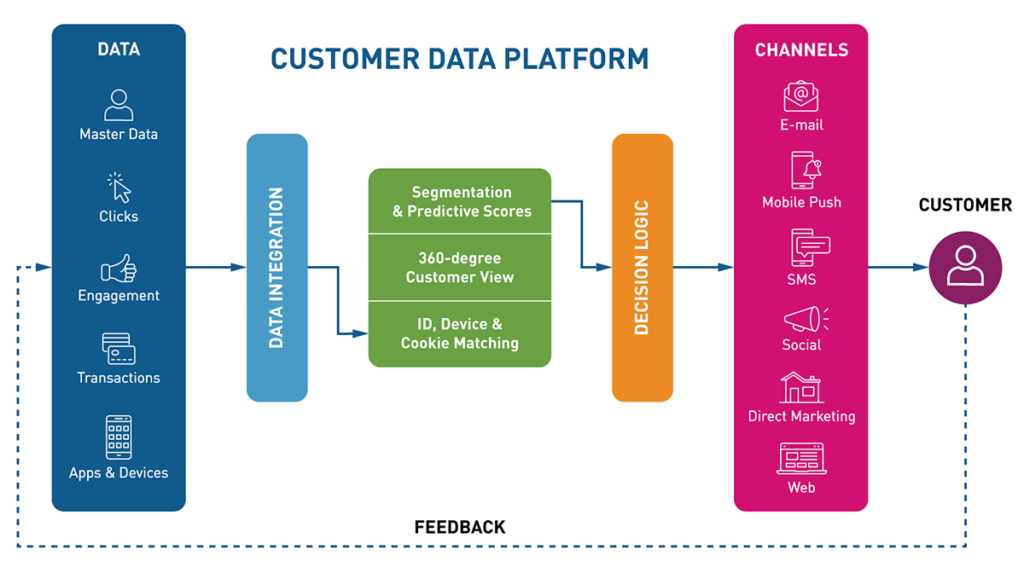
Approaching customers digitally with the Customer Data Platform (CDP)
Customer centricity is essential when it comes to establishing digital business models. It requires the best possible knowledge of where those customers currently are in their individual customer journey. Data management technology is key here. Customer data platforms (CDPs) are increasingly being used to collect and analyze data.
Find out more about this type of software below: What functions and advantages it has and how you can use it to prepare your company technologically for the potential of digital customer data.
Getting started: What is a Customer Data Platform (CDP)?
A Customer Data Platform is a software solution that combines and standardizes customer data from different systems so that they can be used to build personalized customer profiles for marketing, sales, and customer service purposes.
These customer profiles can then be used, for example, to determine whether a customer has just visited the website, consumed certain content there, interacted with the company’s social media profile, signed up for a newsletter, etc.
Technically speaking, the CDP must first and foremost be able to establish the interfaces to all data-generating touchpoints. This is no easy feat since these platforms and systems are usually highly diverse. But only by integrating customer data can you have a customer-centric approach. From a customer’s perspective, it is irrelevant where they made an inquiry or interacted with the system – the company has to respond quickly and effectively.
Customer Data Platforms collect data, as do data warehouses. In the past, so-called data lakes were used for data management. All data was stored in them. The analysis applications then had to “fish out” the right data packages from this large lake. The data warehouse is a more efficient approach. Here, the raw data is pre-structured for later use. The analysis applications can help themselves to the packages tailored to them, just like in a department store.
But a Customer Data Platform goes even one step further. It prepares the raw data for further processing in a user-friendly manner. In contrast to the data warehouse, CDPs can assign the collected data to specific customers, and they operate in real-time and are specifically designed for interaction with customers.
The Customer Data Platform thus sets the stage for further data processing in the context of business intelligence (BI) and predictive analytics. This is because only consolidating all relevant data sources and allocating them to individual customer profiles enables meaningful analysis using statistical methods.
The following graphic shows how such a Customer Data Platform can be structured:
Functions and benefits of a CDP: More than just a customer database
The approach of collecting customer data or storing it centrally in a customer database in the cloud is by no means new. But modern Customer Data Platforms offer a wide range of functions that reflect the state of technology.
Specifically, a Customer Data Platform can be used to perform the following tasks:
- Consolidation of different data sources – First of all, it is an integration software for all data sources related to customers. These are, for example, web analytics, e-commerce systems, POS records, contact centers for customer service, social media platforms, and so on.
- Creation of data-based customer profiles – All incoming data is assigned to an individual customer profile in the Customer Data Platform. What the customer did and when can be seen at a glance. This can be addressed with both manual and automated responses to provide a personalized customer experience.
- GDPR-compliant data management – Data management in a Customer Data Platform also meets the legal requirements on data protection and security. The software systems of European providers in particular, such as SAP, offer the functions required.
- Reporting and data analysis – Conclusions for business success can be drawn from the cross-section of all existing customer profiles. For example, this shows how the current customer lifetime value (CLV) is calculated – and at which points optimization of the customer journey is required to improve it.
- Process and marketing automation – Finally, the Customer Data Platform offers a tool for automating processes through its customer database. In the context of marketing automation, for example, personalized journeys can be planned in advance on the basis of specific trigger actions. The system then triggers them automatically, without the need for manual intervention.
- Predictive analytics using artificial intelligence (AI) – Finally, the Customer Data Platform is the starting point for using AI models for deeper data analyses. In the context of predictive analytics, customer behavior can thus even be statistically predicted. This allows future business decisions to be based on probability calculations – minimizing risks and increasing success. An AI solution also helps to continuously refine and improve the model and its predictions.
These and other functions clearly demonstrate the power of such a solution. However, it should also be noted here that using a Customer Data Platform only pays off with a correspondingly broad database. This means that it is particularly relevant for companies with a very large customer base.
Use cases: A customer data platform for marketing, sales, and service
The most important use case of a Customer Data Platform is to map the complex digital customer journey across many touchpoints and systems in a central hub. The customer profiles and dashboards enable all employees involved in customer relations to choose the right form of addressing the customer at the right time.
This procedure is key for maintaining competitiveness in the digital age. After all, customers today are more accustomed to personalized experiences than ever before. This is reflected, for example, in an individual social media newsfeed or personalized suggestions in e-commerce. Consumers are growing increasingly likely to switch providers if addressed the wrong way.
This means that marketing, sales, and customer service must join forces. The common goal of customer-centricity brings their tasks together. A Customer Data Platform is the prerequisite for these activities to complement each other. For example, Marketing can use lead scoring to indicate to Sales which prospect profiles are “ready” for closing a deal. Similarly, Sales can pass service inquiries in advance to Customer Service, which in turn can pass cross-selling and up-selling options for existing customers to Sales. The Customer Data Platform thus also makes 360° customer-centricity organizationally feasible.
Another advantage is the personalization of the customer address. With the help of gathered data, you can tailor offers and marketing campaigns to individual needs. In e-commerce in particular this opens up interesting opportunities to improve user experience and increase sales. The technical starting point for this is the individual customer profiles stored in the Customer Data Platform. Platforms based on both AI and ML can support marketers in the continuous analysis of customer data. This enables optimal interaction with customers. On the customer side, modern Customer Data Platforms place a lot of emphasis on GDPR-compliant turnover with customer data and offer them extensive control over their information.
The right Customer Data Platform: Choosing the right provider
There are numerous software systems for Customer Data Platforms on the market. The market research institute Gartner regularly reports on Customer Data Platforms and their development status. Big names like Adobe, SAP, and Salesforce are among them, as are smaller and more specialized providers.
For companies, choosing the right provider of a Customer Data Platform is a challenge that should not be underestimated. After all, there is a whole range of criteria that need to be taken into account. These include:
- Interfaces and integration capability
- Data security and GDPR compliance
- Support and further development by the provider
- Technological basis, including programming languages and databases
- Developer community and partner ecosystem
- License fees and other costs
Requirements management plays an essential role in the implementation of a Customer Data Platform. Only when the exact requirements and the data strategy are clearly defined can the optimal choice be made.
Your partner for the CDP solution: We support you in all phases
Is this topic of interest to you? Then contact us today for a virtual meeting or to get to know us in person at our Munich office: experts@striped-giraffe.com.


